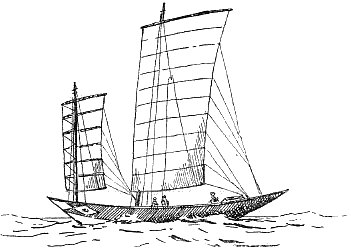 Whole
families live in it, like rabbits in a hillside,
burrowing in and out of its lofty sides, living, playing,
eating, sleeping (and, of course, gambling) in its nooks
on deck, or in its depths below, for months and years, at
sea, in port, in typhoon and calm. Whole
families live in it, like rabbits in a hillside,
burrowing in and out of its lofty sides, living, playing,
eating, sleeping (and, of course, gambling) in its nooks
on deck, or in its depths below, for months and years, at
sea, in port, in typhoon and calm.
The bow of the junk is not its least
characteristic feature. Over a staging standing on a big
transverse beam fitted to the stem-head, and projecting
over each bow so as to answer the purpose of a cat-head,
are fitted the anchor windlasses, and here may be seen
the great single fluke wooden anchors with shanks twelve
or more feet in length, and weighted often with huge
stones, which are a relic of very ancient times.
*1*
*1* Cf. the Iliad.
A peculiar wing is often fitted to the
windlass staging upon which the eye of the ship is
painted. The eye is never omitted by the Chinese any more
than by the Maltese or the old classical sailors, for, as
John Chinaman most logically says, 'If no have got eye,
how can see?' These wings or cheeks are often gaily
painted, <-> as in ancient days.
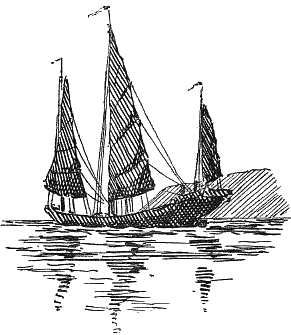
On his decks in the waist of the ship
the thoroughness of the Chinese sailor may be studied,
for every kind of conceivable sea-store is there stowed;
not neatly, certainly, but
handily, ready for when wanted; and erring only, if it be
possible where men have to fight such a veritable
storm-hell as the China Sea, on the side of size and
strength. Huge windlasses stand under the masts for use,
like the <-> of the ancients on the halyards; and
big capstans, the ancient <-> are used for the
heavy grass warps. *1*
1 From the derivation of the word and the context in
which it occurs in Lucian the translation 'capstan' here
adopted appears to be in every way a more suitable
rendering than that given by Mr. Smith in his Voyage and
Shipwreck of St. Paul. It is suggested by him there that
these 'drive-abouts' were oars or paddles placed forward
for helping the ship round when slack in stays. There is
no evidence, I think, that any seamen have ever used
means of this nature in the forepart of the ship for this
purpose, and indeed they would be inefficient and
unnecessary substitutes for the oars with which even the
Roman merchant ships, which depended principally on sail
power, were equipped upon each side, which could always
keep steerageway on the vessel and, if necessary, back
upon one side and pull on the other and thus get her
round at any moment. Moreover, the old form of
paddle-rudders <-> can be used with great power in
bringing a sluggish vessel round, and would render a
resort to such a device comparatively rare. On the other
hand, the handspike and capstan appear to have been known
to the ancients both in the East and in the West, and the
handling of the heavy ground-tackle was one of the first
problems which had to be solved by the early seamen when
the size of sea-going vessels was
increased.
JUNK IN WINTER QUARTERS
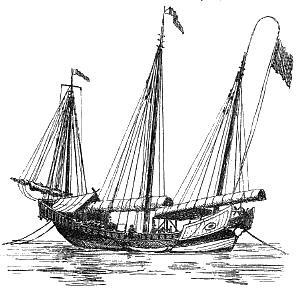
They have wandered far, these
Chinese sailors : *1* to the east coasts of Africa, or to
the Malay Archipelago; one meets them in the Bay of
Bengal, or the Gulf of Siam; away off Manilla; anywhere
between 10 degrees south latitude and 40 degrees north
latitude upon the eastern coasts of Asia.
And wherever they go they leave some
impress of their methods on the maritime peoples whom
they visit, so that even the Malay, sailor as he is,
distinctive as he is, has, as remarked elsewhere, largely
adopted the Chinese lugsail.
*1* A very perfect representation of a
three-masted North China junk is preserved in a fresco in
one of the caves at Ajunta, in India. It is figured in
Torr's Ancient Ships, and must be of considerable
antiquity.
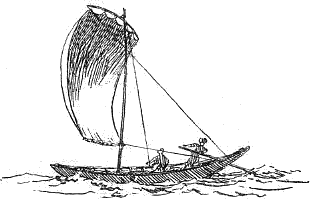 For
ships' boats the sail has long been in use among knowing
skippers in the East, and a ship's lifeboat, rigged with
two of these sails, is one of the handiest forms of
ship's sailing-boat to be met with anywhere. For
ships' boats the sail has long been in use among knowing
skippers in the East, and a ship's lifeboat, rigged with
two of these sails, is one of the handiest forms of
ship's sailing-boat to be met with anywhere.
Among the various productions of the
Chinese boat-builder may be mentioned the stern-wheel
passenger boats of the Canton and West River districts.
The light-draught river steamboats of Yarrow or
Thorneycroft have made the stern-wheel method of
propulsion familiar to us in the West, but in the East,
with coolie labour in place of the steam-engine, the
stern-wheeler is as old as the Chinese nation itself.
>>Next
Part
|

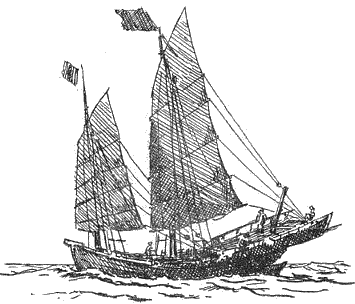
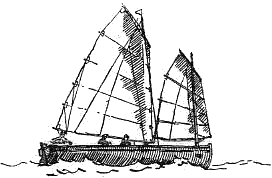
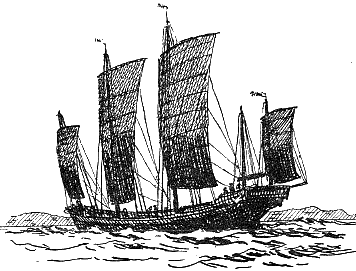
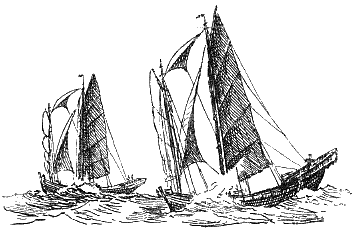
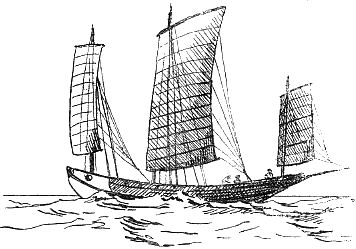 It
is interesting to note that among the big trawlers which
may be met with generally in pairs off the Hainan and
Kwantung coasts, the staysail is used a good deal when on
a long board with the trawl down. Besides a main staysail
between the main and fore-masts, a flying main topmast
staysail is set aloft.
It
is interesting to note that among the big trawlers which
may be met with generally in pairs off the Hainan and
Kwantung coasts, the staysail is used a good deal when on
a long board with the trawl down. Besides a main staysail
between the main and fore-masts, a flying main topmast
staysail is set aloft. Whole
families live in it, like rabbits in a hillside,
burrowing in and out of its lofty sides, living, playing,
eating, sleeping (and, of course, gambling) in its nooks
on deck, or in its depths below, for months and years, at
sea, in port, in typhoon and calm.
Whole
families live in it, like rabbits in a hillside,
burrowing in and out of its lofty sides, living, playing,
eating, sleeping (and, of course, gambling) in its nooks
on deck, or in its depths below, for months and years, at
sea, in port, in typhoon and calm.

 For
ships' boats the sail has long been in use among knowing
skippers in the East, and a ship's lifeboat, rigged with
two of these sails, is one of the handiest forms of
ship's sailing-boat to be met with anywhere.
For
ships' boats the sail has long been in use among knowing
skippers in the East, and a ship's lifeboat, rigged with
two of these sails, is one of the handiest forms of
ship's sailing-boat to be met with anywhere.